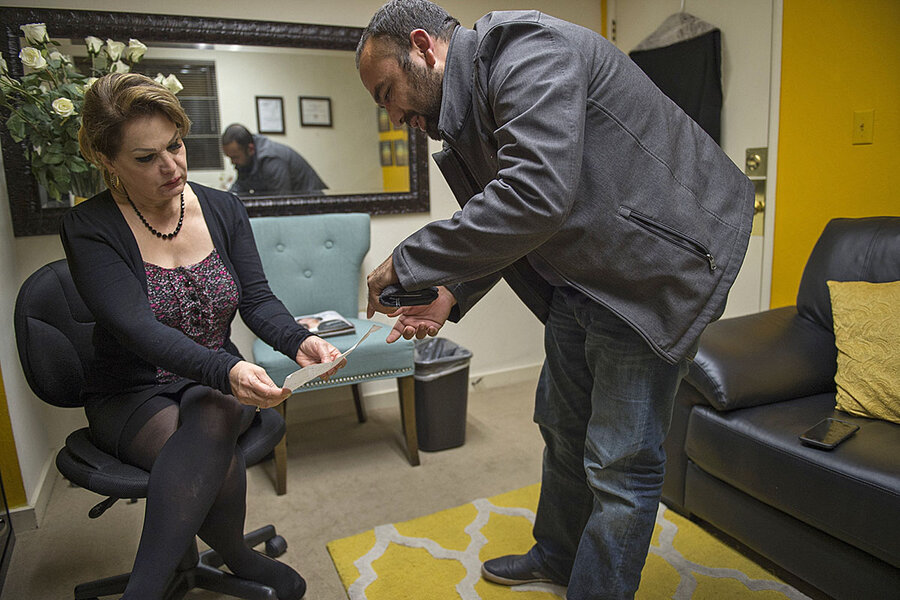They aided US troops at war. Some found safety here. Why are others left behind?
Loading...
| Sacramento, Calif.
The bomb exploded beneath the armored truck on a dirt road in southern Afghanistan. Jawad Khawari recalls staggering from the mangled vehicle with four or five US Army soldiers. They carried one American, the truck’s gunner, clear of the wreckage. He had taken his last breath.
Mr. Khawari, an Afghan serving alongside US troops as an interpreter, suffered a concussion and temporary hearing loss in the blast in 2010. Some months later, on another mission, he was shot in the leg. He considered his injuries the cost of pursuing peace in his homeland.
He signed up for the role and the risk as a 19-year-old in 2009, eight years after American forces invaded Afghanistan and toppled the Taliban in response to the terrorist attacks of Sept. 11, 2001. A close friend’s death in a suicide bombing instilled in the teenager a sense of duty.
Why We Wrote This
Thousands of Afghan and Iraqi interpreters who helped American forces have resettled in the US. But recent immigration restrictions have stranded thousands more, endangering them and possibly US efforts abroad.
“I didn’t want to see any more innocent people dying like that,” says Khawari, who embedded with American troops for three years before joining the US Agency for International Development as a training specialist. “So I decided to help the US military mission and try to reduce the tragedy and violence.”
His choice imperiled loved ones. His father received a letter from the Taliban threatening to kill Khawari, his parents, and his siblings if he continued assisting the US government. Khawari persisted against his father’s wishes. Yet he realized that, for his safety, he would need to leave Afghanistan if granted the chance.
He applied for a special immigration visa (SIV) that allowed him and his wife to resettle in a suburb of Sacramento, Calif., in 2016. Congress created the first of three programs under the SIV umbrella in 2006 to enable Afghan and Iraqi citizens who worked beside US troops and civilians to immigrate to America. The visas provide an escape from the shadow of retaliation looming over interpreters, translators, security officers, and others who served in support roles.
The United States has accepted more than 70,000 SIV recipients, including the spouses and children of those who aided the US war effort in Afghanistan and Iraq. But as part of new immigration and refugee restrictions under President Trump, the program’s admissions have plunged by almost half in the past two years.
The US State Department reported that 19,321 Afghans and Iraqis arrived between October 2016 to September 2017. For the fiscal year that ends Sunday, the figure had fallen to 10,079 as of this week.
The drop dismays Khawari and other recent SIV immigrants and riles advocates who contend the administration has enacted a short-sighted strategy that will yield long-term harm. Former Army Capt. Matt Zeller, the co-founder of No One Left Behind, a nonprofit based in Virginia that works to bring Afghan and Iraqi interpreters to the United States, calls the policy change “an absolute betrayal.”
“It’s going to get people killed,” says Mr. Zeller, who credits his Afghan interpreter with saving his life during a firefight with Taliban militants in 2008. “And not only Afghans, Iraqis, and their families, but US troops.”
Trapped in SIV limbo
The decline in the number of Afghans and Iraqis settling in California under the SIV program parallels the national trend. The state accepted 3,621 Afghans and Iraqis through Sept. 24, compared with 6,738 last fiscal year.
California has welcomed 21,000 SIV holders since 2006, the most of any state, with 90 percent arriving from Afghanistan. More than a third moved to Sacramento County, making it the nation’s largest diaspora of Afghan SIV recipients.
Federal officials have linked the overall decrease to intensified vetting of immigrants and refugees. In the view of Karen Ferguson, executive director of the Northern California chapter of the International Rescue Committee (IRC), one of the country’s primary resettlement groups, the Trump administration has reneged on a moral obligation.
“The only way Afghans and Iraqis can apply for the special immigration visa is to work with US troops or civilians, and that’s how they end up a target of violence,” Ms. Ferguson says. “If we’re going to have a program that literally puts people in the crosshairs, then we should be responsible for their safety.”
Khawari and his wife traveled to California two years ago with three suitcases and a sense of hope. The uncertainty felt mild in contrast to his last years back home, when he moved every few months and limited visits to his parents to once or twice a year to avoid detection by the Taliban.
“This change in the visas is painful to me. The Afghan people work faithfully with the Americans at great risk to themselves, and the US has turned its back on them,” says Khawari, who waited four years to receive his SIV. “By not giving them visas, a lot of really, really good people are being left behind. Maybe they will survive. But I know I couldn’t live in Afghanistan anymore.”
Wahidullah Rasuli echoes that worry for his friends trapped in SIV limbo. He served as an interpreter for US troops and civilians for six years starting in 2010. For 18 months after quitting, he never left his native Kabul, fearing the Taliban would hunt him down if he traveled beyond the capital. Last December, when the State Department granted his visa following a three-year delay, he immigrated with his wife and their 9-month-old daughter to Sacramento.
“My friends are in danger and their families are in danger,” says Mr. Rasuli, who works in technical support for a phone company. “They are waiting so long for visas, now they are wondering why they helped the Americans.”
The backlog of SIV applicants stranded in Afghanistan and Iraq has swelled to more than 100,000. Zeller predicts that, with the chances of acquiring a visa reduced, fewer people in those and other countries where the US military has deployed troops will choose to assist them.
The diminished cooperation will hurt efforts to gather intelligence on enemy fighters, he adds, a concern that Pentagon personnel and dozens of federal lawmakers have raised in recent weeks. Zeller has emphasized the same point in his own exchanges with officials, and he asserts that as they offer national security as a rationale for enhanced vetting, the SIV bottleneck subverts that precise aim.
“This is a national security issue in that it increases the risk for US troops,” he says. “The number of Americans who will die in ongoing and future wars because of this should haunt these people in the administration for the rest of their lives.”
‘People want to help’
Ahmad Ghory knew he needed to escape Afghanistan after Taliban militants attempted to kidnap his two young sons as they played outside one afternoon in 2011. He praises the quick actions of Kabul police officers for preventing the boys, then ages 3 and 5, from forever vanishing from his life.
Mr. Ghory had worked for the State Department as a transportation manager for almost a decade at that point. The next year, after receiving special immigration visas, he and his wife brought their children to Sacramento, where he found a job as a caseworker with the IRC.
He helps Afghan immigrants acclimate to California and navigate its bureaucratic maze, whether applying for jobs and apartments, obtaining a driver’s license, or filing tax forms. He provides advice on transportation options, grocery stores, and Afghan restaurants, and he reassures them that they will regain their emotional balance in time. The work at once sustains his bond to Afghanistan and deepens his gratitude to America.
“When you come from another country and culture, it is a big adjustment,” Ghory says. “You don’t know who to trust or how you will be treated. But it is lucky to be in California. The people here seem to understand immigrants.”
Mr. Trump has limited refugee admissions to 30,000 for the upcoming fiscal year. The figure marks the lowest total imposed by a president since the country launched a resettlement program almost 40 years ago, dropping from 45,000 this year and 85,000 in 2016.
The president’s hardline stance on immigration and the rhetoric of anti-immigration activists has led the IRC to add a tutorial for recent arrivals that explains their rights if law enforcement officials — or civilians — ask for their visa paperwork.
Amid the cultural friction and sporadic attacks on immigrants, Ferguson, with the IRC’s Northern California chapter, has seen more residents volunteering to host and assist newcomers to the country. A comparable surge has occurred at other IRC offices across the country.
“People want to help,” she says. “That’s what’s especially disheartening about the drop in admissions: It in no way reflects the overall attitude of communities.”
On a recent afternoon, Ghory talked while sitting in the tidy apartment of one of his clients, Ahmad Rashid Jamal, who lives outside Sacramento and works for the California Department of Justice. He and his wife immigrated from Afghanistan in August last year through the SIV program, two months before the birth of their first child.
Mr. Jamal held positions with a pair of US agencies in Kabul. Driving to his office on a converted military base one morning in 2014, he saw a cloud of smoke rising from near its entrance. A suicide bomber on a motorcycle had blown himself up, killing five security guards. If traffic had moved a little faster that day, Jamal realized, he would have been waiting to enter the front gate at the time of the blast.
The frequency of such attacks in Afghanistan informs his perspective on the tensions over immigration in his adopted country. “In California, there are maybe not as many problems as in some states,” Jamal says. “But even in other states, you don’t have this feeling of being afraid every day of suicide bombers and militants shooting at people. That is a different fear.”
Khawari shares a similar outlook, and while he misses his family and aspects of Afghanistan, he had grown weary of living like a hostage in his own country.
Soon after arriving in Sacramento two years ago, he went to work as a cultural adviser with the aid organization World Relief. He has felt at ease among Americans, even as he senses that some hesitate to approach immigrants out of unfamiliarity or fear.
“We know it is not perfect here and there are problems,” he says. “But you have your rights as a human and a chance to grow. This is good.”






